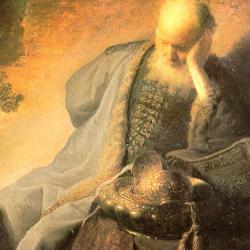Jeremiah 46 is an oracle against Egypt, which, like Judah, is threatened by the advancing forces of Babylon. In the space of four verses (20-23), Jeremiah runs through a dizzying series of metaphors.
Egypt is a pretty heifer (v. 20), and Nebuchadnezzar’s army is a “horsefly” that is going to sting Egypt without mercy.
In verse 21, Egypt’s mercenaries are another sort of bovine – fatted calves. Of course, fatted calves are useful mainly for butchering and sacrifice, and that’s just what Babylon will do to Egypt’s warriors.
Verse 22 turns to the army itself. Its voice (qol) moves along (halak) like a serpent. That’s a multiply odd phrase: The voice moves; the voices moves like a serpent (slithering? silently? hissing?); the voice that moves like a serpent is literally an army.
Before the verse ends, the serpent-army has become a forestry crew, armed with axes to cut down the forests of Egypt.
The tress of the forest (apparently) are numerous, more numerous than locusts that blanket the land. Though the trees are as abundant as locusts, they will be completely removed so that none will be found (v. 23).
What is Egypt? A heifer to be stung. A fatted calf to be slaughtered. A forest that to be cut down. A locust plague that will be blown away.
What is Babylon? A horsefly. Sacrificial priests. A serpent slithering through Egypt. Woodcutters.
What do we do with this mish-mash of imagery. We might say that our takeaway is only the overall impression of devastation.
But the metaphors and similes have too much resonance with the rest of Scripture to leave it at that. Egypt-as-calf brings up not only the whole sacrificial system, but the fairly common prophetic trope that links war with sacrificial slaughter, a sacrificial slaughter that not only destroys but in some way purifies. To call Nebuchadnezzar’s army a “serpent” (nachash) with a “voice” calls up all sorts of associations – not least because Egypt itself is a “great serpent” (as Shakespeare knew). It seems that Nebuchadnezzar’s serpent-army is swallowing up Rahab, the serpent of the Nile, as Moses’ serpent-staff devoured those of Egypt’s magicians. Forests and axes appear in the Psalms to describe the destruction of Jerusalem’s temple, which was literally constructed from the forest of Lebanon. Is Jeremiah describing the destruction of Egypt’s temples? The association of locusts with Egypt takes us back to the plagues of the exodus; there Egypt was overwhelmed with locusts that were eventually blown into the sea – foreshadowing Pharaoh’s armies that were themselves overwhelmed in the waters of the Red Sea.
So, what is going on in Egypt looks like a repeat in some way of the Exodus, now with Nebuchadnezzar rather than Moses as Yahweh’s agent of destruction.
And we might also wonder if there is some logic in the sequence in Jeremiah 46 itself. Is a fly stinging a heifer somehow like a priest slicing the throat of a calf for sacrifice? How is a sacrificer like a serpent, and how is a serpent like a collection of woodcutters with axes? Are we supposed to connect the sacrificial imagery of verse 21 with the wood of verse 22, to make a full sacrificial image: Babylon will not only slaughter the Egyptians, but prepare a great sacrificial fire with the “trees” it cuts? How are trees like locusts?
Biblical imagery leaves an “overall impression.” But its defamiliarizing mixed metaphors also seem designed to connect things that we might not be inclined to connect, to present a tapestry of interconnected threads, a mosaic of mutually-reflective fragments.















